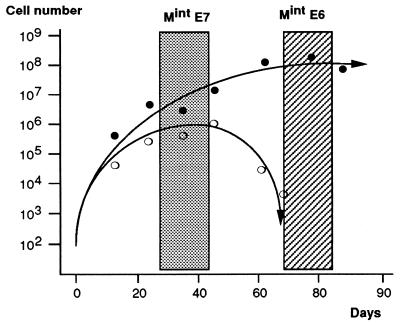FIG. 3.
Contrasting kinetics of growth arrest at MintE6 and MintE7. Approximately 2 × 105 HDF at <3 PD from senescence were infected with vectors expressing neo plus either HPV E6 (solid symbols) or E7 (open symbols), selected in G418 and maintained in culture with passage as necessary for up to 3 months. Changes in total population size were calculated from passage ratios, and cell counts were performed at the indicated intervals. The initial number of stably infected G418-resistant cells at time 0 was estimated from the colony yield in parallel experiments conducted at clonal density. (No direct cell counts were possible until G418 selection was complete by day 10.) Both E6- and E7-expressing cultures escape senescence and grow for several weeks. With E6, this is followed by a stable state of growth arrest, referred to here as MintE6 (hatched zone). In contrast, E7 cultures show only a temporary stationary-growth phase, termed here MintE7 (shaded zone), which is followed by progressive net cell loss. These boxed zones of the growth curves define the phases at which cultures were used for all other analyses of the Mint phenotypes. Results shown are means of two representative experiments in each case, together with best-fit curves.

